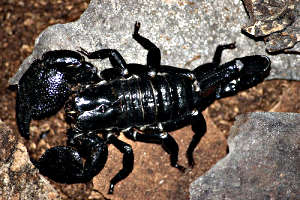Q: You have a specimen in your collections that is noted for being the most poisonous bird in the world. Do you have more information on it?
A: It is the Hooded Pitohui (Pitohui dichrous). An Academy researcher, Jack Dumbacher, experienced the toxicity of these birds first-hand when he was doing research in Papua New Guinea and decided to study them more. He found that they sequester poisons from something they feed on, much like poison dart frogs.
Q: Do owls really see in total darkness like your matching game says?
A: Renowned for their solemn, spooky mien, owls have large eyes that face forward, and arrangement that's rare even among predatory birds. This gives them binocular vision and the resultant depth perception necessary to judge distances with almost pinpoint accuracy. These fast-focusing eyes are also equipped with a mirror-like membrane that lets them sample extremely dim light twice, and a dense concentration of light-sensitive cells in the retina. While owls may not be able to see everything in total darkness, they can see what other nocturnal predators might miss.
Q: What is Arsenic and Strychnine made out of?
A: Arsenopyrite is an iron arsenic sulfide (FeAsS). Strychnine is an alkaloid extract obtained from the dried ripe seeds of Strychnos nux vomica, a small tree of the East Indies.
Q: Someone told me that the red-winged blackbirds only have that red flash in mating season - is that correct?
A: According to Western Birds, QL 683 .W4 P4 1990, these epaulets are 'most conspicuous' in the spring time, suggesting that they are there all year round but brighter in the mating season.
Q: Do you know that saying about claw and tail sizes of scorpions that tells you which ones are more poisonous than the other?
A: The simple, although not universal, rule is that scorpions with thin pedipalps (claws) and thick tails tend to be more venomous than those with stout pedipalps and thinner tails. Working through this in a logical way, we can think that a scorpion with a large claw may be able to subdue its prey with the claw. If it has thin claws, it may need to rely more on the venom from the stinger to make up for its lack of strong claws. For more information about scorpions, click here. There is also a very well written amateur information page here.
 What does the size of a scorpion's claw mean?
What does the size of a scorpion's claw mean?